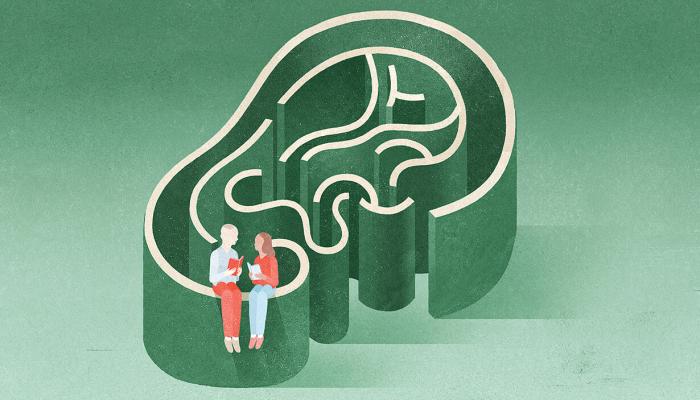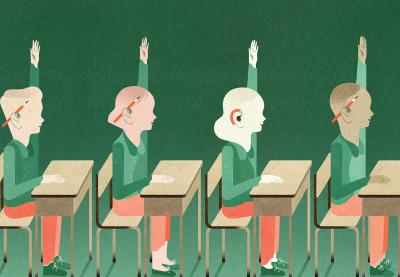Alissa, 17, recalls a day that exemplified her sad, disconnected year as the only hard-of-hearing student in a mainstream middle school classroom. The teacher was dividing the class into groups to work on a project. “When he came to me, he said, ‘You can work alone.’” She felt sentenced to invisibility all year. “The teacher and the other kids just didn’t bother talking to me,” Alissa says.
A recent shift toward mainstreaming deaf and hard-of-hearing (D/HH) students in public schools has created both opportunities and challenges for students like Alissa and her teachers. While mainstreaming may offer D/HH students the chance to attend schools that are closer to their homes (as opposed to residential or day schools for the deaf) and prepare them for life in the hearing world, many educators feel ill-equipped to help this student population or even to know if they are reaching them at all.
D/HH children comprise 1 percent of the overall population of school-age students, so they tend to be widely distributed among neighborhood schools; many classroom teachers have little experience with D/HH students because they encounter these students in such small numbers. As a result, teachers in general education settings—while often well-meaning—are rarely trained on how to identify when D/HH students are faltering or how to access the services these students need.
This reality carries grim consequences for many D/HH students. Without the proper supports, these students may adapt to the patterns and expectations of a mainstream classroom—including using their voices to communicate—but miss out on critical academic content and social experiences.
Seen But Not Heard
In their book Turning the Tide: Making Life Better for Deaf and Hard of Hearing Schoolchildren, researchers Gina A. Oliva and Linda Risser Lytle found that D/HH students often felt isolated on mainstream campuses and wished they had benefited from special services like sign-language interpretation, tutors or amplification technology. Unfortunately, nobody seemed to realize they needed these services—and they didn’t ask.
If a child’s hearing loss adversely affects educational progress, she can qualify for special services under the Individuals with Disabilities Education Act (IDEA). Some 1.2 percent of students served under IDEA have hearing impairments, reports the U.S. Department of Education. These young people typically have an Individualized Education Program (IEP), with accommodations decided on by an IEP team that meets periodically. An array of special services is supposed to be tailored to the students’ needs.
But the federal data doesn’t track the extent of services or their effectiveness over time. Lisalee Egbert, associate professor of deaf studies at California State University, Northridge, notes that D/HH students are “entitled to [a free, appropriate public education], but too often they’re not receiving it.” Sometimes students don’t have IEPs, or their IEPs aren’t adequately updated as they progress to secondary school. Students may need tutors or specialized speech and language instruction, but the help never appears.
Having a teacher advocate can be the difference between deep engagement and just getting by for students who need accommodations but aren’t getting them.
The potential for academic delay is huge. Lags tend to begin early; hearing is critical to speech and language development, and many preschool kids aren’t taught full communication through signing or oral methods. By secondary school, the majority of D/HH students fall behind academically.
Making the Connection
In their research, Oliva and Lytle found one variable that made a positive difference for D/HH students was the presence of caring teachers who were also well-informed on issues related to hearing loss.
Cheryl Kaler, a guidance counselor at Mississippi School for the Deaf in Jackson, spent 15 years consulting in mainstream settings. She encourages all teachers to become familiar with common indicators that a D/HH student may need services or isn’t fully grasping what’s being taught in the classroom: barely participating in class discussions; frequently appearing disengaged or “glazed-over”; nodding and smiling but rarely speaking; not turning in homework; and appearing to “get it” in class, but scoring low on tests. It’s also dangerous to assume that a student who talks a lot understands everything that happens in class.
So, if students appear to be missing content, what are their options? Larger campuses may have resource rooms where the D/HH students can attend classes with special education teachers trained on teaching youth with hearing loss. Some districts employ deaf-education specialists who travel between schools to supplement academic instruction and consult with general classroom teachers, if needed. But in the absence of these services, it is critical that adults throughout the school know how to teach and advocate for D/HH students.
Connect early and often.
Deaf-education experts advise teachers who know a D/HH student will be entering their class to schedule a private conference with the student and, ideally, her family. A conference can help identify where the student will be most comfortable sitting and offers the opportunity to make some strategic agreements, such as using a secret signal to indicate that the student has gotten lost or needs further explanation. Most importantly, a meeting can establish trust early on. If a teacher understands the student’s interests, enthusiasms and preferences for communication, she maximizes the chance the student will feel comfortable communicating about successes and challenges throughout the year.
Create a D/HH-friendly classroom.
At the classroom level, some best practices might seem obvious but—as Alissa’s story illustrated—are often overlooked. Marcia Kolvitz, a program specialist at pepnet 2, an agency focused on post-secondary transition for D/HH students, encourages simple adjustments to make the classroom a welcoming and accessible environment. For example, teachers should make sure D/HH students can see their faces while they lecture and pause speaking when they turn to write on the board; standing in front of a window where they could become backlit should be avoided. Ideally, educators should seat students in a semicircle so all students can see one another’s faces. Video presentations should always have captioning, and assignments should be given in writing or via the Internet. It is much easier for D/HH children to follow class discussions when students consistently raise their hands before speaking; it also helps if the teacher repeats or restates classmates’ questions. Finally, it’s best to list any new or specialized vocabulary before class starts, as D/HH kids may have trouble catching unfamiliar words.

Know the available supports.
While some D/HH students may resist accommodations out of a desire not to appear “different,” others may just need some help accessing the supports they are entitled to. Some of the most common accommodations in public schools include:
- amplifying systems that transmit sounds from a microphone attached to the teacher directly into students’ ears;
- live-captioning technology that displays classroom dialogue on a screen or laptop;
- note-takers or sign-language interpreters who attend class with the student; and tutors.
Interpreters pose special issues. Quality standards and pricing for sign language interpreters vary greatly from state to state, note Oliva and Lytle. At the secondary-school level, interpreters need subject-matter language expertise (e.g., chemistry or history) as well as sign-language skills. If a student is working with a sign-language interpreter, teachers should check in frequently (and privately) to see if the student feels she is understanding the work and keeping up, recommends Heidi Corce, a deaf-education specialist in Eugene, Oregon.
Having a teacher advocate can be the difference between deep engagement and just getting by for students who need accommodations but aren’t getting them. Teachers can enlist the support of the district’s special education coordinator, deaf-education specialist (there is often one based on campus at larger schools) or contact the traveling deaf-education specialist associated with the district. Enlisting the help of parents or guardians can also strengthen the case for aides, services and technology that can help a D/HH child.
Funding Fundamentals
Unfortunately, accommodations equal dollars, and tight budgets are one reason D/HH students can end up falling through the cracks. Kolvitz sympathizes with school officials strapped for funds and struggling to get mainstreamed D/HH children the education they deserve, but says the bottom line is clear: “We have to make a commitment to meet these kids’ needs.”
One important development that affects services for D/HH students is the Workforce Innovation and Opportunities Act (WIOA), recently signed into law by President Obama. Under WIOA every state is required to invest in the connection between education and career preparation. This means the partnership between schools and Vocational Rehabilitation (VR) programs must start earlier (as early as 14), where previously these services would become available the summer before a student’s senior year. Fifteen percent of every VR budget is now dedicated to pre-employment transition services, which can include ACT preparation, apprenticeships and “soft skills” development opportunities, and are available to students through their 21st year.
Bedarius Bell Jr., state coordinator of Deaf and Hard of Hearing Services for the Alabama Department of Rehabilitation Services, notes, “It’s up to VR and the schools to put the ‘innovation’ in WIOA.” He points to programs like the Oregon Youth Transition Program, jointly managed by VR, the Oregon Department of Education and the University of Oregon College of Education (among others) which places VR counselors in classrooms to team teach career-exploration activities and help with individualized transition and career-development planning.
Understanding the bigger picture of what VR and other state-level programs and legislation can offer is another important step educators can take in supporting D/HH students, both during their K-12 careers and beyond. In most states, for example, VR will pay for some or all college expenses. Many VR programs will send students out of state to historically deaf schools like Gallaudet in Washington, D.C., or National Institute for the Deaf on the campus of the Rochester Institute of Technology in New York. Legislation in Texas allows D/HH students to go to in-state colleges for free.
An Emerging Practice in “Mainstreaming”
Alissa is now a college-bound senior attending University High School in Irvine, California. After a demoralizing middle school experience, she is now happily integrated at an unusual campus lauded by deaf-education experts as an example of secondary school mainstreaming that fully meets the academic and social needs of D/HH kids and benefits all students by building a culture that respects differing abilities.
University High School is an example of a mainstream program that clusters D/HH kids from multiple schools into one regional secondary school. While not a widely used model, many deaf-education experts wish more districts would follow suit and combine strengths—and dollars.
All school announcements at University High are video-captioned on overhead boards, and D/HH students participate in nearly every extracurricular sport and activity. Interpreters support almost every school function and American Sign Language is offered as a language elective (a popular class that enrolled many hearing students too). When deaf athletes make a great play or are acknowledged with honors at assemblies, hearing students wave their arms overhead, demonstrating the deaf version of applause. This supportive acceptance from classmates reflects mainstreaming that supports the identity of D/HH students. The school also brings deaf artists, lawyers, auto mechanics and college officials to speak to all students on campus—hearing or non.
Says Principal Jon Levy, “We want them to know deaf people can do incredible things.”

